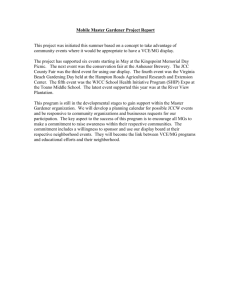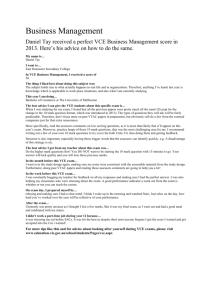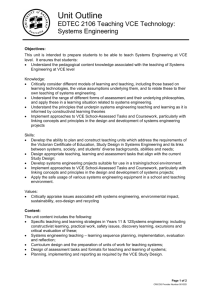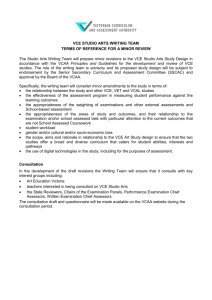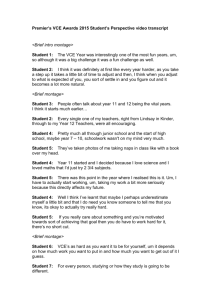Chapter 17 – The Marketing Plan & Evaluation of Performance
advertisement
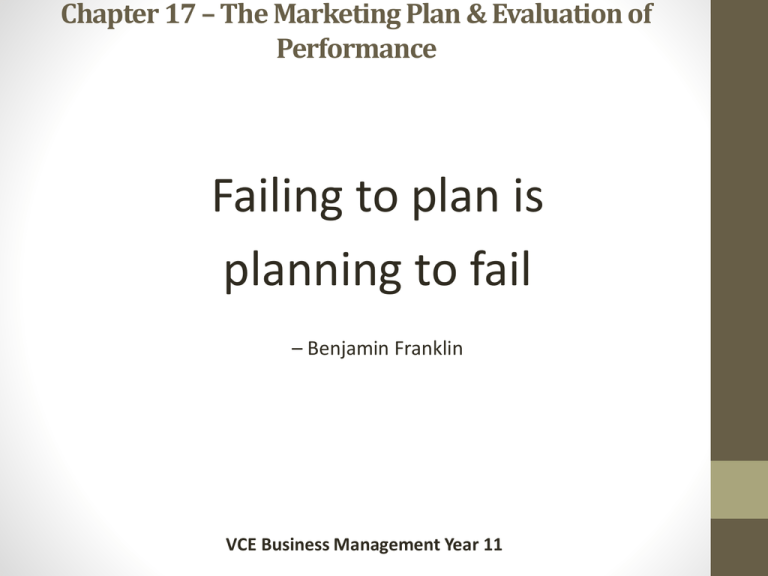
Chapter 17 – The Marketing Plan & Evaluation of Performance Failing to plan is planning to fail – Benjamin Franklin VCE Business Management Year 11 Chapter 17 – The Marketing Plan & Evaluation of Performance • What you’ll learn in the next two lessons • • • • • - The key elements of a marketing plan - establishing objectives - marketing mix (product, price, place & promotion) - expansion strategies such as exporting and diversifying - relevant performance indicators to evaluate effective marketing strategies Chapter 17 – The Marketing Plan & Evaluation of Performance Elements of a marketing plan A marketing plan is a written document that can stand alone as an individual plan or form part of the overall corporate business plan. There are a number of key elements or questions that must be included in the plan What is our present situation? Where do we want to go? How do we get there from here? Have we achieved what we set out to do? VCE Business Management Year 11 Chapter 17 – The Marketing Plan & Evaluation of Performance What is our present situation? This requires the business to undertake the following situation analysis 1. Consult its mission statement 2. Conduct a SWOT 3. Gain information on competitors strengths and weaknesses 4. Determine what customers want and who they are 5. Check if there are any gaps in the market (market niche) not currently being met VCE Business Management Year 11 Chapter 17 – The Marketing Plan & Evaluation of Performance What is our present situation? Consult the business mission statement – This statement indicates why the business currently exists and should continue to exist What is Coca Cola Amatil’s Mission Statement? To refresh the world... To inspire moments of optimism and happiness... To create value and make a difference. VCE Business Management Year 11 Chapter 17 – The Marketing Plan & Evaluation of Performance Conduct a SWOT What are your STRENGTHS? What are your WEAKNESSES? What are your business OPPORTUNITIES? What are your business THREATS? See Table 17.1 on Page 298 for a list of possible areas that could be considered when conducting a SWOT analysis. What are your businesses? Conduct a quick SWOT analysis VCE Business Management Year 11 Chapter 17 – The Marketing Plan & Evaluation of Performance Gain information on your competitors strengths and weaknesses. What can you do better? Take advantage of their weaknesses. Example of a business weakness that you could take advantage of? Coca Cola? McDonalds? Coles? Woolies? Anyone else? VCE Business Management Year 11 Chapter 17 – The Marketing Plan & Evaluation of Performance Determine what customers want and who they are & Check if there are any gaps in the market (market niche) not currently being met. What’s an example of a niche market? http://www.thesolopreneurlife.com/6-cool-examples-of-successfulniche-businesses/ VCE Business Management Year 11 Chapter 17 – The Marketing Plan & Evaluation of Performance Where do we want to go? As a business, you need to make a decision as to the overall direction that you want to take your business or brand. This requires setting & having MARKETING OBJECTIVES – short term, medium term, long term. These could relate to either one or a combination of the following ATTRACTION – to attract new customers RETENTION – To maximise existing customer relationships VCE Business Management Year 11 Chapter 17 – The Marketing Plan & Evaluation of Performance How do we get there from here? This part of the plan incorporates identifying the target market, the positioning strategy, the marketing mix (Product, Price, Promotion, Place) (chapter 18) VCE Business Management Year 11 Chapter 17 – The Marketing Plan & Evaluation of Performance Growth strategies related to PRODUCT are product development, product extension (Lipton Ice Tea) and developing brand recognition. For PRICING your strategy might be to offer value added pricing on selected services to attract new customers To attract new customers you may require to expand your store locations – PLACE Can you give me an example of PROMOTION to attract new customers? Or to value add to existing customers? VCE Business Management Year 11 Chapter 17 – The Marketing Plan & Evaluation of Performance Have we achieved what we set out to do? Budgets, evaluations methods and controls must be included in a marketing plan. Why? So comparisons can be made to assess the the progress of the marketing strategies against the marketing plan. This measures how effectively the product is meeting the demands of the marketplace, the pricing strategy adopted, the distribution channels and the promotional activities (Product, Price, Place & Promotion) VCE Business Management Year 11 Chapter 17 – The Marketing Plan & Evaluation of Performance Complete Activity 17.1 1. 2. 3. 4. 5. VCE Business Management Year 11 Chapter 17 – The Marketing Plan & Evaluation of Performance • Evaluation – was the marketing process effective? • This is the last step in the marketing process • • • • Step 1 – Market Research Step 2 – Marketing Strategies Step 3 – Marketing Mix Step 4 – Evaluation Chapter 17 – The Marketing Plan & Evaluation of Performance • Evaluation allows you to see and judge how well the first three steps worked for the business. • Now is the time to reflect on what improvements can be made • This is the stage where you check that your goals have been met • There are a number of ways to evaluate how you performed. Chapter 17 – The Marketing Plan & Evaluation of Performance • Sales analysis • Comparing actual sales with sales objectives set at the commencement of the planning period • We want to sell 100 burgers with this promotion, we normally sell 50 burgers • How many did you sell? Was it more or less? Was the promotion successful? • How could you break this down further? Chapter 17 – The Marketing Plan & Evaluation of Performance • Market Share Analysis Market share analysis provides a comparison of how well a business is performing in relation to its competitors Lipton Ice Tea for example hold the market share over Nestle. There are 4 Lipton Ice Tea’s sold for every 1 Nestea. Can you think of any other market leaders? How do you think they analyse this data? Where do they get the data from? Chapter 17 – The Marketing Plan & Evaluation of Performance • Marketing expense-to-sales analysis • Businesses need to keep an eye on how much it is costing them in salespeople, advertising, sales promotion, market research and sales administration for every dollar of sales revenue • How much are we spending v how much are we making? • If this cost of spending is too high, and the sales too low has it been an effective promotion? Chapter 17 – The Marketing Plan & Evaluation of Performance • Profitability Analysis • It is important for a business to analyse whether certain products or geographic areas are more profitable to the business than others. Examples? Chapter 17 – The Marketing Plan & Evaluation of Performance • Customer Based Measures • • • • • • The number of new customers The number of repeat customers The number of dissatisfied customers or lost customers Target market awareness Loyalty Brand Awareness Chapter 17 – The Marketing Plan & Evaluation of Performance • Complete • Activity 17.2 Chapter 17 – The Marketing Plan & Evaluation of Performance • Issues in Marketing • Issues in marketing can range from the changing role of technology and our interaction with it to the social and moral responsibilities of marketers Chapter 17 – The Marketing Plan & Evaluation of Performance • Issues in Marketing - The Role of Technology • How has the role of technology changed the way we market products and services? • • • • Newspapers Radio Magazines TV • What has changed? Why is this change good for small business? Why is this good for large business? Chapter 17 – The Marketing Plan & Evaluation of Performance • Issues in Marketing - Global & Domestic Business Market • The domestic business market is regarded as the geographical boundaries of Australia. • But worldwide there are potential customers who have needs to be satisfied and money to spend. • Australian companies need to be aware also of aggressive overseas competitors who see Australia as an expansion opportunity. Chapter 17 – The Marketing Plan & Evaluation of Performance • Should an Australian business decide to market globally, it needs to be aware of • • • • • Social Cultural Religious and Language differences between countries. Legal and Political differences are also important because of trade barriers that could be in place (ie: Australian Beef & Russia) Chapter 17 – The Marketing Plan & Evaluation of Performance • Examples of language issues when marketing overseas • Pee Cola – ‘Very Good Cola’ in Ghana • Barf Detergent – ‘Snow’ in Iran • It takes a tough man to make a tender chicken – in Spanish means “it takes a well hard man to make a chicken affectionate • Fart Bar – Means ‘Lucky’ in Polish • http://mentalfloss.com/article/31168/11-product-namesmean-unfortunate-things-other-languages Chapter 17 – The Marketing Plan & Evaluation of Performance • Issues in Marketing -Ethical and Socially responsible marketing Read: Ethical and Socially Responsible Marketing (page 306) on Complete: Activity 17.3 (Q 1 &2) Chapter 17 – The Marketing Plan & Evaluation of Performance • Issues in Marketing – Legal Requirements • There are a range of laws in place to protect consumers and to regulate marketing practices. The overall purpose of the Competition and Consumer Act 2010 (Commonwealth) is to protect consumers against actions taken by producers and distributors of products & unfair competition. • Businesses also need to protect their trademark, as trademark provides an indication of quality being associated with a particular product or service • Can you give me an example of a business that would protect its trademark so consumers were confident of that product or service? Chapter 17 – The Marketing Plan & Evaluation of Performance • Expansion strategies in marketing • Exporting • Exporting is an excellent method for businesses to use when wanting to expand their market. • Can you think of any countries that would require a product or service from Australia? What would they be? Why would this be? Chapter 17 – The Marketing Plan & Evaluation of Performance • Expansion strategies in Marketing – Innovation and diversification • For a business to be innovative, they usually have created a better product or service, improved the method of production or come up with an unusual approach to increase their appeal to the marketplace. • Activity 17.4 • Questions 1 to 11 Chapter 17 – The Marketing Plan & Evaluation of Performance • Expansion Strategies in Marketing – Research & Development (R&D) • Feedback from customers can lead to R&D of current products to find an improved product to offer to the marketplace. • Read page 311 and can you think of any other products or services that have undergone R&D on the basis of feedback from customers? Final Chapter Summary Q’s • Page 312 – Q • 1a, b, c, d, e, f, g, h • 2 • 3 a, b, c
